A Short Trek in Bhutan's Wild East
By Michael Buckley
Where the yaks and the Yetis roam—and where Brokpa nomads weave their legends
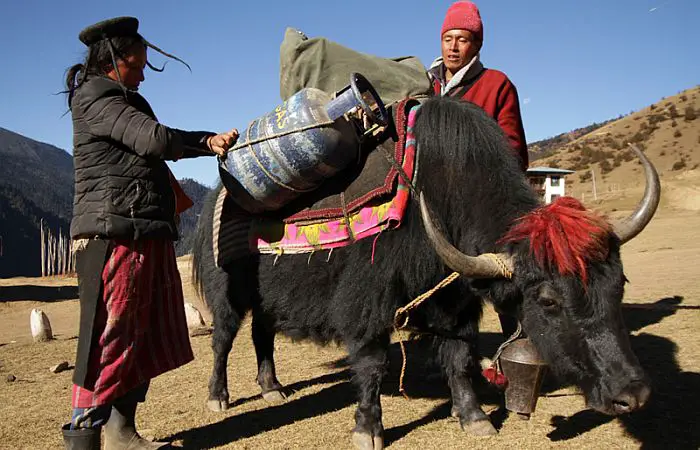
Our 4WD vehicle has reached the end of the road. This pot-holed dirt track is the furthest east you can drive in Bhutan. From here, the only option is traveling on foot. In the tracks of Bigfoot. “Welcome to Bigfoot Valley, Sakteng Wildlife Sanctuary,” a sign announces. This region has been set aside for wildlife—and supposedly to give Yetis a place to roam and find peace.
They have not only found peace—they have completely eluded Yeti-spotters employed by the Bhutanese government. Nonetheless, the high-altitude snowman is celebrated in Bhutan. A set of triangular Bhutanese postage stamps features the hairy beast of the far east. The toughest hike in the world is named after the Yeti: the Snowman Trek. This trek, right across the Himalaya range of northern Bhutan, takes almost a month to complete—if the hiker actually manages to pull that feat off.
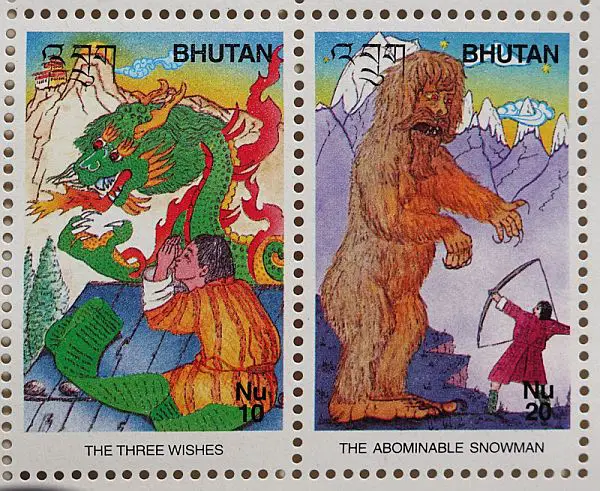
So far, the hairiest part of this trip has been traversing the main east-west road by 4WD to get to our trek start-point. The road is being widened from one lane to two. Which is being done in random order for the entire length. This means you have no idea when you drive around a corner whether a cliff-face is being dynamited or being excavated from a recent landslide, with precipitous drops off the side of the road.
The trip to Sakteng is best done in the spring or summer. But my timing is November—where a narrow window of time, post-monsoon, permits you to reach Sakteng Wildlife Sanctuary before the icy grip of winter really closes in—when temperatures plunge to minus 15 Celsius overnight in December and January.
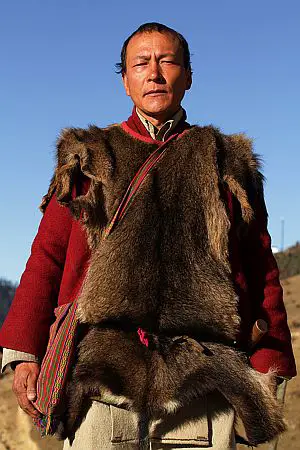
The only ethnic group inside the sanctuary is the Brokpa. Sometime in the 7th century AD, Brokpa nomads fled Tsona in southern Tibet to escape an oppressive chieftain. They brought their most precious possessions with them—their yaks. They also brought their legends and beliefs. Over a millennium later, the Brokpa are still yak-herders, semi-nomadic in nature, living inside Sakteng Wildlife Sanctuary. Bhutan includes ethnic groups in its national parks and wildlife sanctuaries—unlike what happens in neighboring Tibet where nomads are booted out of so-called national parks to make way for Chinese mining ventures and megadam building.
Encountering the Brokpa
We set off trekking with guide, cook, and wranglers, urging along horses that carry all our gear. Treks in Bhutan must be fully self-supported. We’re hiking in yak country now, and they're bounding away, scared of us. On the horizon, we see some tantalizing snowcaps. A few hours into the hike, we have our first encounter with the Brokpa. They’re a group of horsemen, foisting bowls of home-made moonshine on us. Some men are clad in serge-red woolen jackets. Others are wearing hairy jackets made from ghoral, a wild goat.

The Brokpa are a tough-looking lot: they have a dark complexion, and curlier hair than Bhutanese. Women wear a distinctive felt hat, made from yak-hair and shaped to the head, with parts woven into extensions that act to drain off rainwater. The moonshine offering is of uncertain alcoholic strength. Staggering onward and upward after this encounter, we finally reach the village of Merak.
First stop next morning: the village school, to present some books and crayons we have brought along as gifts. The atmosphere is tense: the school is under lockdown with all the kids arrayed across a field outdoors, bent over papers, doing their final exams. Each kid has a felt piece attached to his or her rear, to sit on—a practical Brokpa innovation.
We wander around the town, poking our heads into small shops. One place seems to serve as a bar, with men gathered on benches outside drinking beer and eating chilli paste. Chili paste? Yes, the Bhutanese are very fond of chilies, adding them to almost every dish. And somehow the chilies keep finding their way into my food. The biggest mystery of this trip thus far is why the food continues to be laced with chilies. I have asked our cook to cool it, as they aggravate my lips, cracked from exposure to the elements. Then the food arrives, spicier than ever. The cook denies any chili additions.
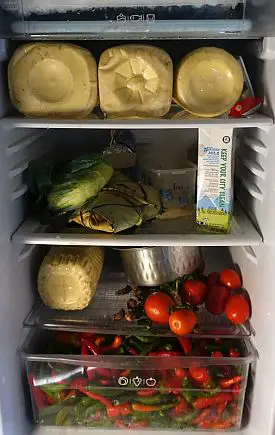
We go to the cooking area. I pick up a bottle with chilies prominently displayed. Did you use this sauce? He laughs. Of course not! Then I pick up another bottle showing a graphic of tomatoes on the front, labeled Tomato Chili Sauce. How about this one? The cook nods in the affirmative. Turns out he cannot read—in Bhutanese or English. He is going by the illustrations on the bottles.
The Brokpa are fairly self-sufficient in the food-line, deriving everything from their yaks and their sheep and goats. They make their own yak-milk, butter, curd and cheese. But they need to barter for chilies, tea, salt and other addictive items. Some shops have a fridge—a big fridge. To get here it was carried in on some poor porter’s back. Inside the fridge: bags of chilies, and rows of a very stinky cheese made from yak-milk. It is used to flavor yak-meat soup.
The Brokpa conduct a big trade in yak-cheese, which is stored inside animal skins and shipped to towns in Bhutan and also carried by porters across the border to Tawang in Arunachal Pradesh, in India. There is also a brisk trade in wool from yaks, goats and sheep. The yak-herding and trading season is winding down due to the cold, and most folks are busy chopping up wood for winter, where they gather around wood-burning stoves that double as cooking devices.
Yak-assisted Trek
As we get ready for the next leg of the trek—up and over a high pass, disaster strikes. The horseman who is supposed to carry all our gear has backed out at the last minute. But out of calamity can come better things. Pema, my guide, rushes frantically around the village and hires a herder with half a dozen yaks. We will be on a yak-assisted trek instead. The yaks eye us suspiciously and put up a valiant struggle against being loaded with gas canisters, cooking gear, and duffle bags. But once they are coaxed past the village gates, they give up and start eyeing the lush pastures beyond.
The day is long and strenuous, but ultimately rewarding, with sublime views of distant Himalayan snowcaps. We eventually crest 4,140-meter-high Nyukang La, marked by prayer flags. To my great disappointment, we have not spotted any wildlife, except birds. Maybe the wildlife is observing us, but is too stealthy for us to spot it. Pema explains that yak-herders out in remote pastures get glimpses of wildlife. Sometimes unwelcome glimpses as there is conflict with wildlife that goes after baby yaks or sheep. A snow leopard will attack a baby yak. So will packs of wild dogs. And rarely, one of their yaks just plain disappears—perhaps taken by a Yeti.
Making slow progress on the knee-jarring descent from the pass, we are caught out in dense bamboo and rhododendron forest at twilight. Coniferous trees look surreal because they have heavy loads of goat-beard moss hanging off them. Everything creaks, swaying in the wind, and the imagination starts working overtime. Is something stalking us?
Copyright (C) Perceptive Travel 2017. All rights reserved.
- Into the Depths of the Sahara in Algeria by J. Jaye Gold
- A Hermit's Prayer on Salvation Mountain by James Michael Dorsey
- Recapturing My Religious Satirical Soul in Lutherland, Germany by Becky Garrison
- Travel Book Reviews
Books from the Author:

Buy Tibet, Disrupted online here:
Apple iBooks
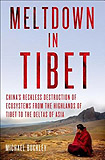
Buy Meltdown in Tibet at your local bookstore, or get it online here:
Amazon US
Amazon Canada
Amazon UK
Kobo

Buy Tibet: the Bradt Travel Guide at your local bookstore, or get it online here:
Amazon US
Amazon Canada
Amazon UK

